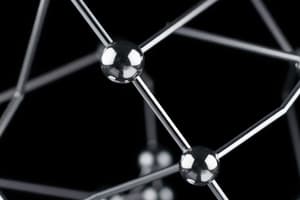Podcast
Questions and Answers
What is the structure associated with the term 'Linear'?
What is the structure associated with the term 'Linear'?
- 2 bonds, 1 or 2 lone pairs
- 4 bonds, 0 lone pairs
- 2 bonds, 0 lone pairs (correct)
- 3 bonds, 0 lone pair
What is the structure associated with the term 'Bent'?
What is the structure associated with the term 'Bent'?
- 2 bonds, 1 or 2 lone pairs (correct)
- 3 bonds, 0 lone pair
- 2 bonds, 0 lone pairs
- 4 bonds, 0 lone pairs
What is the structure associated with the term 'Trigonal Planar'?
What is the structure associated with the term 'Trigonal Planar'?
- 3 bonds, 1 lone pair
- 5 bonds, 0 lone pairs
- 3 bonds, 0 lone pair (correct)
- 4 bonds, 0 lone pairs
What is the structure associated with the term 'Trigonal Pyramidal'?
What is the structure associated with the term 'Trigonal Pyramidal'?
What is the structure associated with the term 'Tetrahedral'?
What is the structure associated with the term 'Tetrahedral'?
What is the structure associated with the term 'Trigonal Bipyramidal'?
What is the structure associated with the term 'Trigonal Bipyramidal'?
What is the structure associated with the term 'Octahedral'?
What is the structure associated with the term 'Octahedral'?
What is the structure associated with the term 'Seesaw'?
What is the structure associated with the term 'Seesaw'?
What is the structure associated with the term 'T-shaped'?
What is the structure associated with the term 'T-shaped'?
What is the structure associated with the term 'Square Pyramidal'?
What is the structure associated with the term 'Square Pyramidal'?
What is the structure associated with the term 'Square Planar'?
What is the structure associated with the term 'Square Planar'?
What does VSEPR stand for?
What does VSEPR stand for?
What is VSEPR?
What is VSEPR?
Flashcards are hidden until you start studying
Study Notes
Molecular Geometries under VSEPR Theory
-
Linear
- Geometry with 2 bonds and 0 lone pairs of electrons.
-
Bent
- Geometry resulting from 2 bonds with 1 or 2 lone pairs, leading to a non-linear shape.
-
Trigonal Planar
- Features 3 bonds and no lone pairs, creating a flat, triangular structure.
-
Trigonal Pyramidal
- Comprises 3 bonds plus 1 lone pair, resulting in a pyramidal shape with a central atom at the apex.
-
Tetrahedral
- Consists of 4 bonds with no lone pairs, forming a three-dimensional shape resembling a tetrahedron.
-
Trigonal Bipyramidal
- Characterized by 5 bonds and 0 lone pairs, creating a structure with two triangular bases.
-
Octahedral
- Includes 6 bonds and no lone pairs, resulting in a symmetrical octahedral shape.
-
Seesaw
- Contains 4 bonds and 1 lone pair, producing a structure that resembles a seesaw due to differing electron pair repulsion.
-
T-shaped
- Formed by 3 bonds and 2 lone pairs, creating a "T" shaped configuration.
-
Square Pyramidal
- Comprises 5 bonds and 1 lone pair, leading to a square-based pyramid shape.
-
Square Planar
- Consists of 4 bonds and 2 lone pairs, resulting in a flat square geometry.
VSEPR Theory Overview
-
VSEPR Definition
- Stands for Valence Shell Electron Pair Repulsion, a model that predicts molecular shapes.
-
Key Concept of VSEPR
- Based on the principle that electron pairs around a central atom strive to maximize their spatial separation, minimizing electrostatic repulsion and thus determining the three-dimensional structure of molecules.
Studying That Suits You
Use AI to generate personalized quizzes and flashcards to suit your learning preferences.



